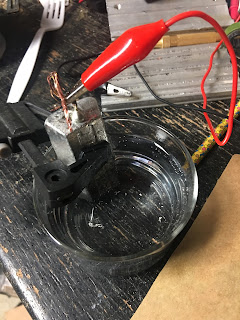NEW PROJECT - 1974 Volkswagen Beetle
I was looking through eBay for electric vehicle conversions and first I came across a 911 cabriolet. I bid but didn't win. Then I found a 1974 VW Beetle in Albuquerque, NM which had been converted. It had high end components with a lithium ion battery pack with BMS, a Elcon charger and a Kostov 10" motor. I bought the car and had it shipped to NJ.
Unfortunately, things were not functioning properly. The batteries were GBS 100 ah lithium iron phosphate. Half of them were half dead. I couldn't get them to charge to the same voltage. The pack sagged really badly when accelerating. I spent $1500 on new batteries and still wasn't happy because the cells wouldn't charge properly. The weaker cells would charge first and stop the charging process before everything was fully charged.
 |
| GBS Cells with sense boards in rear compartment |
 |
| Elite Power Solutions BMS display |
 |
| Elite Power Solutions BMS |
I learned from this experience that it is much easier of all the cells are the same age and have the same characteristics. Too much difference causes the BMS to be unable to balance the cells. It is very difficult to keep adding cells and testing the system until it works properly. Also, these cells are bundled in groups of 4. Every time you change a cell, you have to undo the bundle and recompress them to get them to fit. The cells swell over time and often are not easy to get them back in. We bought a shop press to help squeeze the cells together.
 |
| Shop press squeezing GBS cells to fit in pack |
After all that, my brother was using the car and forgot to disconnect the batteries and ran them down. The electronics were set up to constantly draw the main battery pack to keep the DC/DC converter on. This basically killed 1/2 of the batteries that were not replaced. This forced my hand. I was really unhappy with the performance of the GBS cells anyway. I decided to buy another Chevy volt battery pack and reconfigure the electronics. The Elite Power BMS is specific to the GBS cells and would have to be discarded. The charger also wouldn't work with the voltage of the Chevy volt pack so it also can't be used. Luckily the Soliton controller is rated for high voltage. Hopefully we can sell the good GBS cells and the Elcon charger to recoup some of the cost.
As far as BMS, I was hoping to re-use the OEM Chevy Volt BMS. The volt batteries would have to be cut down to fit in the area where the GBS cells were. My preferred configuration is to use the chevy volt pack in two halves paralleled together to make a 180 volt nominal 90 ah pack.
We found a 2015 pack from a salvage yard and had it shipped for $1650 total.
 |
| 2015 Chevy Volt battery pack |
Luckily the pack was good. All cells functioning properly and no damage. We went ahead and disassembled it. This is my second chevy volt pack so it took less than an hour.
 |
| Chevy volt cells taken out of the pack |
We the proceeded to cut them down to rectangular shapes. This involved removing the side portions where the coolant normally circulates. This is dangerous and difficult. It is the only way to fit the cells in the space available. This has been done before, we researched. See
project by Kraig Schultz.
 |
| Chevy volt cells cut on tablesaw |
Once the sides are cut off, there is no way to fasten the cells together since the holes for the threaded rods are also removed. The cells need to be banded together with something. We bought Nifty Products SPSPKIT 252 Piece
Polypropylene Portable Strapping Kit, 3000' Length x 1/2" Width Coil, Black from amazon.
We used
1/8"x5/8" copper bus bar to connect the two rows of battery cells together in parallel. I wanted to prevent corrosion of the contacts so I decided to electroplate the ends of the copper with tin. This is a surprisingly easy process. I first experimented with using
electrical lead free solder as the metal. It worked but did not have the right finish. I then ordered pure
tin ingot and tried again with a 3.6 volt battery and used some sugar as a brightener and no salt to limit current. This came out really nice.
 |
| First try electroplating with solder |
 |
| Video of electroplating. You can see the metal coating the copper and bubbles of gas. |
 |
| End result after scraping with a wire brush. Not optimal. |
 |
| Bending and twisting copper bus bars with vice |
 |
| Finished product before tinning |
 |
| After electroplating tin plating, look at that shine! |
To be continued ...



















